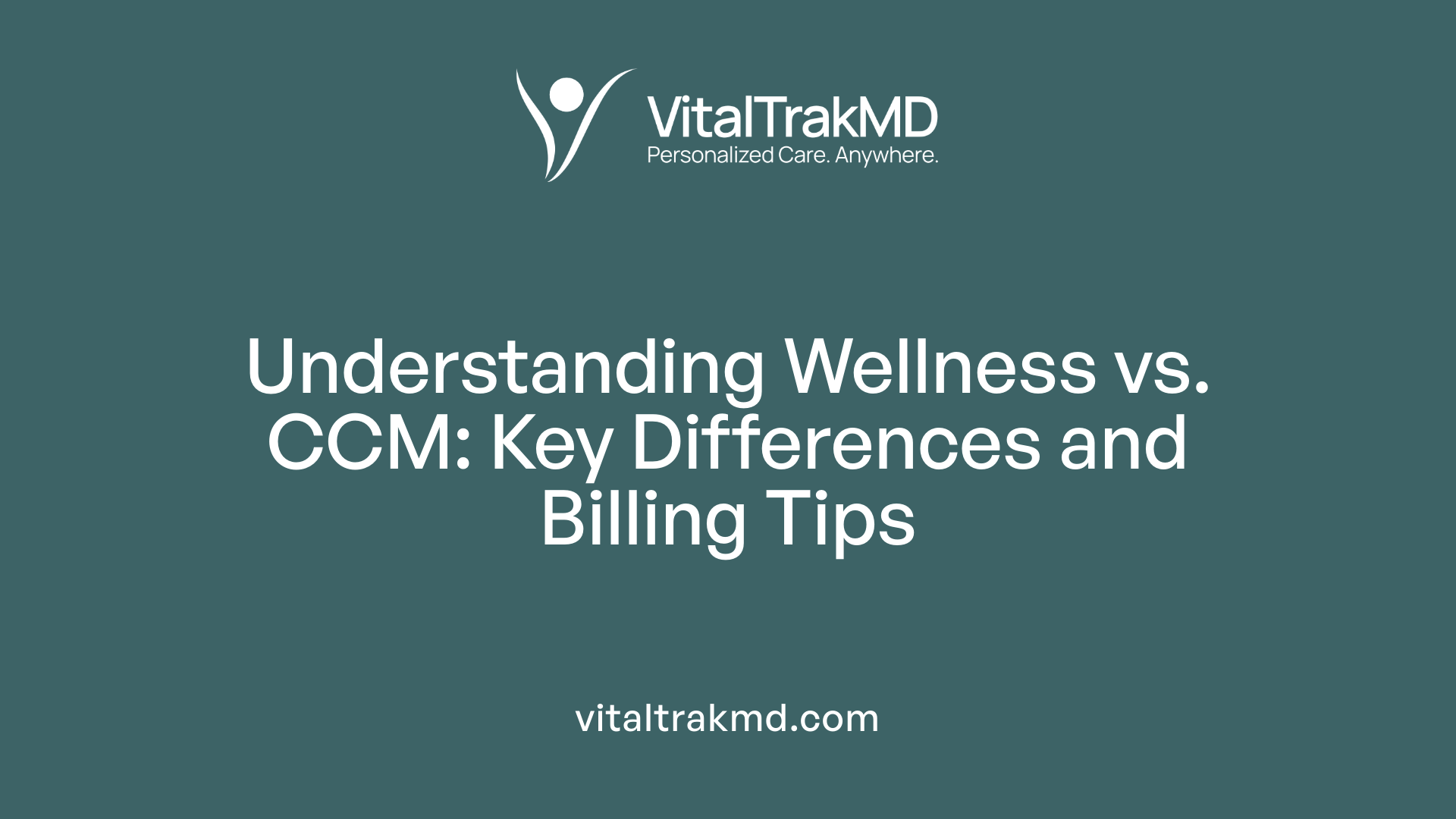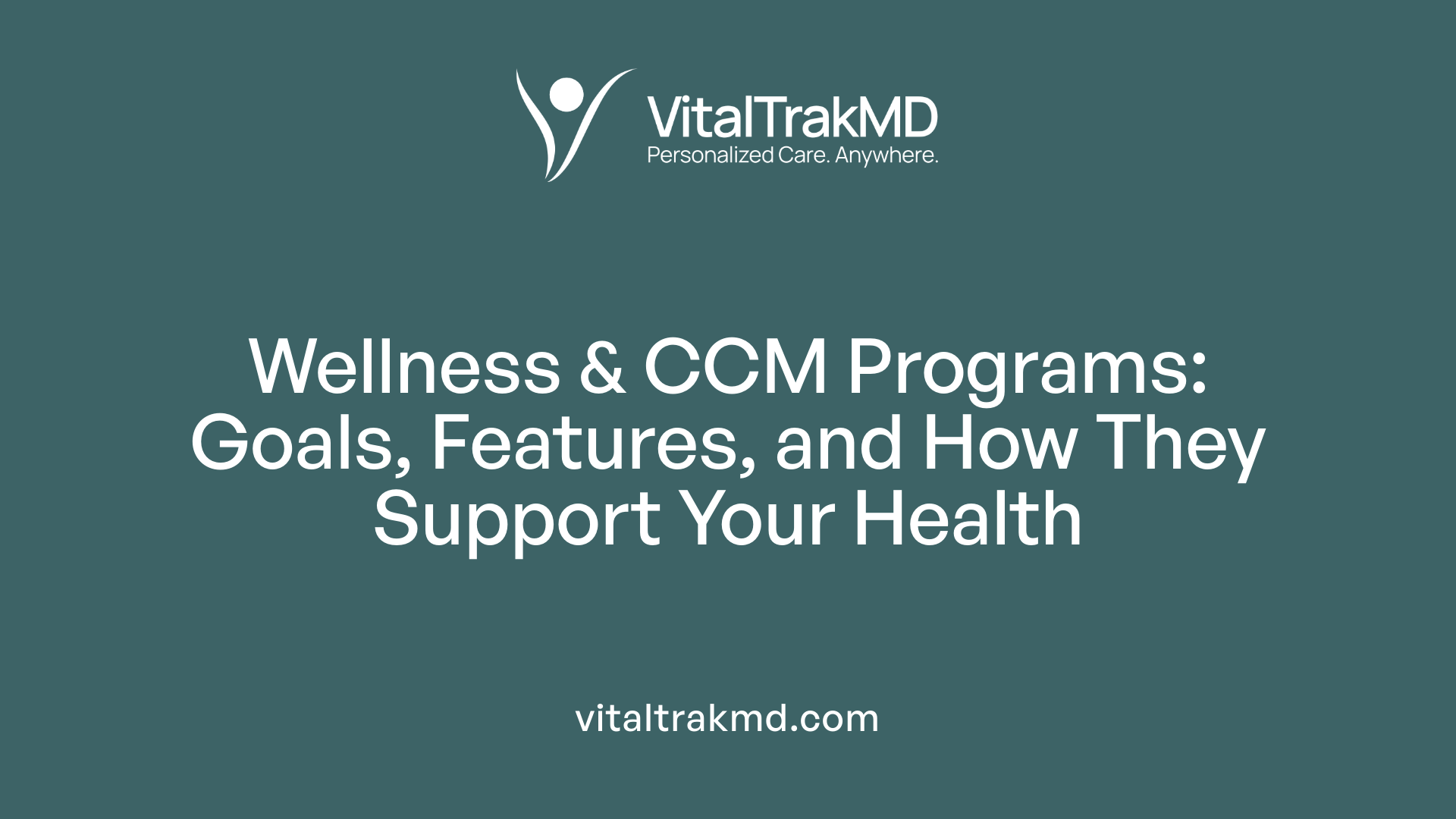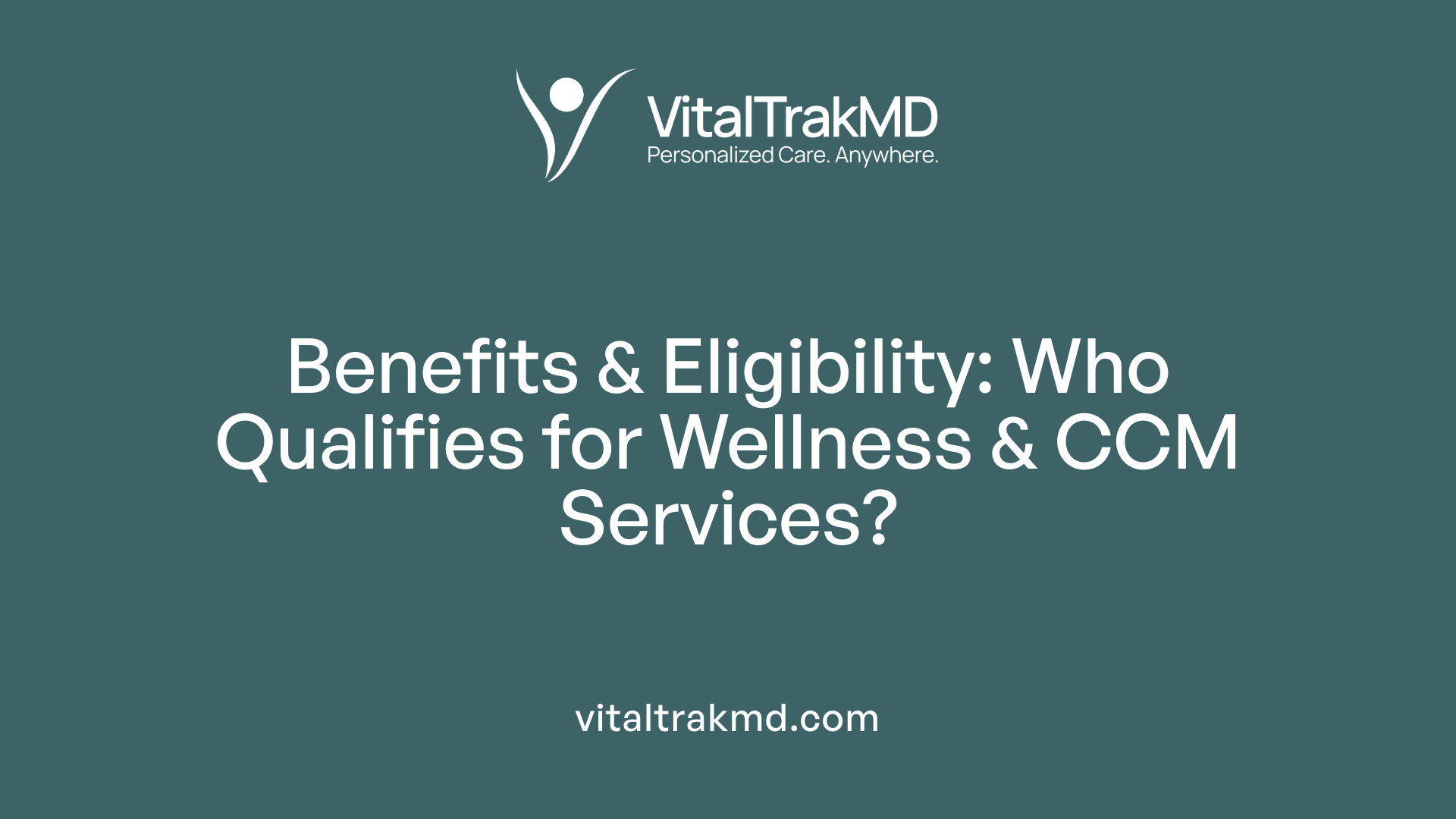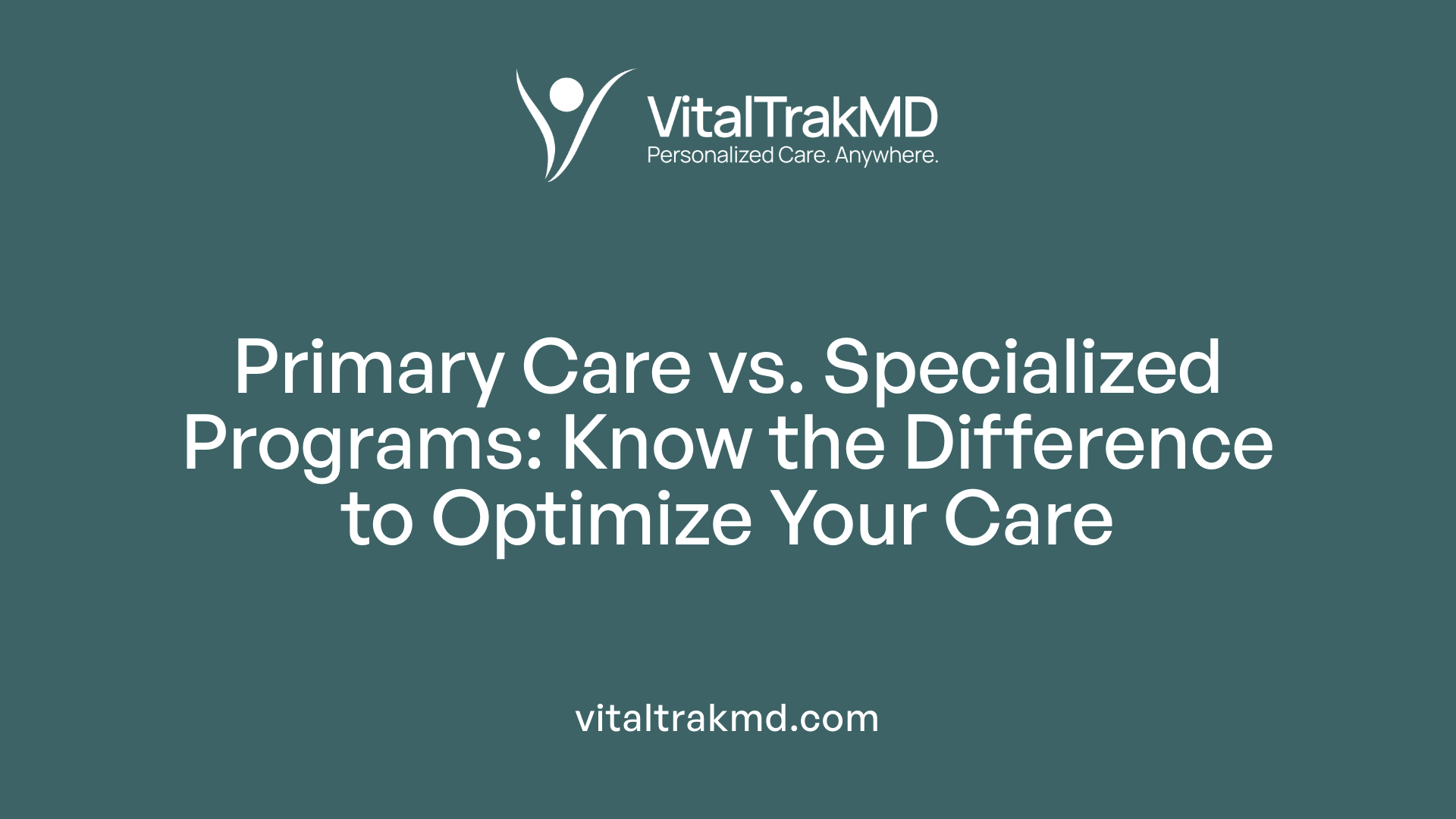What’s the Difference Between Wellness and Chronic Care Plans?

An Overview of Wellness and Chronic Care Plans
Navigating the complex landscape of healthcare requires understanding various strategies designed to promote health and manage chronic conditions. Among these, wellness plans and chronic care management (CCM) services are two foundational approaches, each serving distinct purposes yet integral to comprehensive healthcare delivery. This article explores the key differences, purposes, benefits, eligibility criteria, and how these plans are implemented and billed, helping patients and providers make informed decisions about health strategies.
Defining Wellness Plans and Chronic Care Management (CCM) Services

What are the key differences between wellness plans and chronic care management services?
Wellness plans and chronic care management (CCM) services serve different purposes within the healthcare system, particularly under Medicare coverage.
Wellness plans focus on preventive health and lifestyle modifications. They are designed to promote overall well-being, encourage healthy behaviors, and educate patients about maintaining a healthy lifestyle. These plans are centered around broad health promotion activities such as improving diet, increasing physical activity, and addressing mental health risks. Importantly, wellness plans aim to prevent the onset of disease or manage risk factors to avoid future health complications.
In contrast, CCM services target a specific group of patients—those with two or more chronic conditions expected to last at least 12 months. These services involve comprehensive, ongoing management of complex health issues through coordinated care, primarily with non-face-to-face interactions. The focus is on stabilizing chronic conditions, preventing hospitalizations, and reducing health risks. CCM includes detailed care planning, medication management, care transitions, and continuous communication to address the specific needs of patients with multiple health problems.
Differences in billing and documentation are significant. Wellness visits, which are distinct from physical exams, are covered by Medicare and include health assessments, reviewing medications, screenings, immunizations, and referrals. They do not involve extensive documentation or specific eligibility requirements.
On the other hand, CCM services are billable under specific CPT codes based on time spent and care complexity. They require an initial face-to-face comprehensive evaluation, informed patient consent, a detailed electronic care plan, and regular updates. Healthcare professionals like physicians, nurse practitioners, and clinical staff can provide CCM services under supervision, with strict documentation standards.
Summary table: Wellness plans vs. CCM services
| Aspect | Wellness Plans | Chronic Care Management | Details |
|---|---|---|---|
| Focus | Preventive health, lifestyle | Managing multiple chronic conditions | Targeted at broad wellness vs. complex disease management |
| Eligibility | General population, health promotion | Patients with 2+ chronic conditions lasting ≥ 12 months | Specific inclusion criteria for CCM |
| Service type | Health education, screenings, immunizations | Coordination of ongoing, complex care | Nature of services (preventive vs. management) |
| Billing | Usually not billable | Billable under CPT codes (99490, 99487, etc.) | Based on time and complexity |
| Documentation | Minimal, health assessment report | Extensive, including care plans, progress notes | Required for billing and quality assurance |
| Provider roles | Broad health promotion activities | Medical professionals, clinical staff | Different levels of provider involvement |
Both approaches are integral to patient care but serve different roles. Wellness plans emphasize disease prevention and health promotion, offering a broad approach to maintaining health. CCM services concentrate on managing existing health problems, providing a structured pathway to improve health stability and reduce hospitalizations.
Understanding these differences helps ensure that patients receive appropriate services tailored to their health needs and that providers correctly utilize billing procedures to maximize Medicare benefits.
Further Resources:
- Medicare & You Handbook
- Centers for Medicare & Medicaid Services (CMS) policies
- American Academy of Family Physicians (AAFP) guidelines for CCM
How do the services align to improve patient health outcomes?
While distinct, both wellness plans and CCM services are designed to complement each other, supporting overall health and reducing healthcare costs. Preventive wellness activities can reduce the risk of developing chronic conditions, whereas effective CCM can prevent complications, hospitalizations, and improve quality of life for those with existing health issues.
In the end, a comprehensive approach involves promoting healthy lifestyles through wellness initiatives and providing detailed, ongoing management for chronic disease patients. This dual strategy ensures a holistic, patient-centered care model that emphasizes prevention and effective management.
Purpose and Core Features of Wellness versus CCM Programs

What are the purposes and features of wellness plans versus chronic care management programs?
Wellness plans and chronic care management (CCM) programs serve distinct but complementary roles within the healthcare system.
Wellness programs focus on prevention and health promotion. These plans aim to improve overall health, prevent the onset of diseases, and encourage healthy lifestyle habits. The services include health education, screenings, lifestyle counseling, and resource guidance. They help individuals identify health risks early and develop personalized strategies to maintain wellness.
Features of wellness plans include:
- Regular health assessments
- Education on diet, exercise, and mental health
- Screenings for early detection of health issues
- Counseling on lifestyle modifications
- Immunizations and health screenings as needed
These programs are designed to empower patients to take an active role in their health, emphasizing proactive measures to prevent illness.
In contrast, CCM programs target individuals managing existing, long-term health conditions. These are patients with two or more chronic illnesses expected to last at least a year. The goal is to coordinate continuous, comprehensive care that manages these conditions effectively.
Features of CCM include:
- Care plans tailored to each patient's chronic conditions
- 24/7 access to healthcare team
- Communication through multiple channels including telehealth
- Medication management and review
- Care transitions and referrals
- Regular monitoring to prevent acute exacerbations
CCM emphasizes proactive oversight, ensuring that patients adhere to treatment plans, avoid complications, and reduce hospital admissions. It involves a multidisciplinary healthcare team, including physicians, nurses, and other clinical staff.
How do wellness plans and CCM differ in their goals and approach?
| Aspect | Wellness Plans | CCM Programs | Details |
|---|---|---|---|
| Purpose | Prevent disease, promote health | Manage ongoing chronic conditions | Both aim to improve health but at different stages and needs |
| Focus | Health promotion, risk reduction | Illness management, stability | Wellness is proactive; CCM is reactive to existing problems |
| Services | Screenings, education, counseling | Care coordination, medication, monitoring | Different scope and intensity of interaction |
| Target Population | Generally healthy individuals or early at-risk | Patients with multiple chronic illnesses | Different patient needs and health risks |
| Delivery Method | Preventive, educational, and screening services | Structured, ongoing care management | Duration and intensity vary accordingly |
Search query for more information
For further understanding of how these strategies align with healthcare goals, you can search using the phrase: 'Goals and features of wellness vs CCM healthcare strategies.'
Both wellness and CCM programs play vital roles in a comprehensive healthcare approach. Wellness plans aim to keep people healthy and prevent disease, while CCM ensures that individuals with complex health needs receive coordinated, quality care to enhance their quality of life and reduce healthcare costs.
Assessing the Benefits and Eligibility of Healthcare Strategies

What are the key benefits and eligibility criteria for different healthcare care strategies?
Healthcare management strategies like the Annual Wellness Visit, Chronic Care Management (CCM), and the Advanced Primary Care Management (APCM) focus on prevention, coordinated care, and comprehensive support for patients with chronic conditions.
The benefits of these programs include improved care coordination, better health outcomes, reduced hospital readmissions, and increased patient satisfaction. They help ensure that patients receive personalized health planning, medication reviews, preventive screenings, and continuous access to healthcare teams.
Eligibility for these programs usually depends on specific medical and professional qualifications. For instance, Medicare beneficiaries must have multiple chronic conditions expected to last at least 12 months for CCM eligibility. Patients are typically required to give informed consent and participate in care planning, which involves assessing medical history, current medications, and health risks.
Healthcare providers, including physicians, nurse practitioners, physician assistants, and clinical nurse specialists, need to meet certain criteria to bill for services like CCM. These include documentation requirements such as electronic health record entries, care plans, and time spent on non-face-to-face interactions.
For professionals pursuing careers in healthcare management and delivery, eligibility often involves holding relevant degrees like in healthcare management, medicine, or nursing. They must also possess necessary certifications and experience in managing patient care or healthcare operations.
Additionally, roles such as care coordinators, case managers, and health IT specialists require specific training and skills, framing a career pathway that supports the effective implementation of these programs.
Why understanding these criteria and benefits is important
Recognizing the eligibility requirements helps both healthcare providers and patients access appropriate services. Providers can optimize billing and ensure regulatory compliance, while patients gain access to comprehensive, tailored care.
Furthermore, knowing the benefits supports healthcare professionals in advocating for and implementing these programs effectively, leading to better health outcomes and enhanced patient engagement.
| Program Type | Primary Eligibility Criteria | Main Benefits | Professional Qualifications Needed |
|---|---|---|---|
| Annual Wellness Visit | Medicare beneficiary, no specific health condition needed | Preventive health planning, screenings, risk assessment | Medical providers, health professionals trained in preventive care |
| Chronic Care Management (CCM) | 2+ chronic conditions expected to last at least 12 months | Care coordination, medication management, 24/7 access | Physicians, NPs, PAs, CNSs, clinical staff under supervision |
| Advanced Primary Care Mgmt (APCM) | Medicare patients with varied health risks, including chronic conditions | Flexible care management, remote monitoring, population health | Similar to CCM with additional focus on data analysis and population health |
Understanding these distinctions helps ensure that patients and providers maximize healthcare quality and efficiency.
Distinguishing Primary Care from Specialized Management Programs

How do primary care and specialized management programs like CCM and PCM differ?
Primary care serves as the foundation of the healthcare system, offering broad and continuous health services to individuals of all ages. It includes regular check-ups, preventive screenings, and the management of common illnesses and chronic conditions. Family physicians, internists, and pediatricians are typical providers in primary care, focusing on building long-term relationships with patients. Their role involves coordinating overall health needs and ensuring comprehensive care.
In contrast, programs like Chronic Care Management (CCM) and Program of Comprehensive Management (PCM) are specialized services aimed at addressing specific, often complex, health conditions. These programs are designed to support patients with multiple or complicated chronic illnesses that require dedicated management strategies beyond routine primary care.
Primary Care
- Offers a wide range of services.
- Focuses on prevention, health maintenance, and general management.
- Involves ongoing patient-provider relationships.
- Uses generalist healthcare professionals.
Specialized Management Programs (CCM, PCM)
- Focus on managing specific, complex health issues.
- Typically involve targeted interventions and intensive care coordination.
- Managed by healthcare professionals with advanced or specialized training (like nurse practitioners or care coordinators).
- Aim to improve health outcomes for patients with high health risks.
What are the main differences between primary care and these specialized programs?
| Aspect | Primary Care | CCM & PCM | Details |
|---|---|---|---|
| Focus | Broad, overall health | Specific, complex conditions | Primary care provides general health services; CCM and PCM target specific chronic illnesses. |
| Providers | Family physicians, pediatricians, internists | Nurse practitioners, PAs, specialists | Primary care involves generalist providers; specialized programs often include advanced or dedicated staff. |
| Goals | Prevention, routine management | Disease-specific management, health optimization | General goal is overall health; specialized programs aim at controlling complex conditions and preventing hospitalizations. |
| Care approach | Long-term relationships, coordination | Targeted care, intensive monitoring | Primary care manages overall health; CCM and PCM focus on precise, condition-specific management. |
How do these differences impact patient care?
Patients benefit from the comprehensive approach of primary care, which emphasizes prevention and early management of health issues. When they have complex or multiple chronic conditions, specialized management programs provide the necessary focused interventions, more frequent monitoring, and tailored support. Both types of care are essential for maintaining health and improving quality of life, with primary care serving as the entry point and coordinator, and specialized programs offering in-depth management of serious conditions.
Understanding Chronic Care Models and Billing Procedures
How do chronic care models and management services work, and how are they billed?
Chronic care models focus on providing structured, team-based care for patients who have long-term health conditions, often involving multiple ailments. These models emphasize ongoing coordination and personalized care plans, which are crucial for managing complex, chronic illnesses effectively.
In practice, healthcare teams—comprising physicians, nurse practitioners, clinical nurses, medical assistants, and office staff—work together to deliver non-face-to-face support. This support includes reviewing patient information, managing medication schedules, coordinating referrals, and updating care plans regularly. Patients benefit from continuous communication, including phone calls, secure messaging, and portal interactions, ensuring they are engaged and supported between visits.
Billing for these services relies heavily on detailed documentation of activities and time. Specific CPT codes, such as 99490 for basic chronic care management (CCM) and 99487 for complex CCM, are used based on the intensity of services provided. For instance, 99490 covers at least 20 minutes of clinical staff time per month, while 99487 requires a minimum of 60 minutes and involves moderate to high-complexity medical decision making.
Practitioners who can bill for these services include physicians, nurse practitioners, clinical nurse specialists, and physician assistants. They must document activities thoroughly in electronic health records (EHR), including patient consent, the care plan, and a record of the care management provided. The billing process must adhere to CMS guidelines, ensuring appropriate supervision—services can be furnished by clinical staff under general supervision.
Modern management approaches are expanding to include remote health tools, such as remote patient monitoring (RPM). These tools assist in tracking vital signs, glucose levels, and blood pressure, offering real-time data that supports decision-making and timely interventions. This integration enables healthcare teams to manage conditions like hypertension and diabetes more effectively, aligning with newer billing options and technological advancements.
Overall, these models aim to improve health outcomes, prevent complications, and reduce healthcare costs by facilitating continuous, well-coordinated care outside traditional face-to-face visits.
| Care Model Component | Description | Billing Codes & Requirements |
|---|---|---|
| Basic CCM | Managed with at least 20 mins of clinical staff time per month | CPT 99490; documentation in EHR, patient consent, care plan |
| Complex CCM | Includes at least 60 mins of clinical staff time; higher decision complexity | CPT 99487; detailed documentation, care plan updates |
| Remote Patient Monitoring | Using digital tools to track health data remotely | G2010, G2012, G0316; real-time data sharing, care adjustments |
| Advanced Program (APCM) | Broader, flexible management including multiple conditions | G0556, G0557, G0558; depends on patient risk and needs |
This structured approach not only streamlines care but also ensures providers are properly compensated, facilitating ongoing support for patients with chronic diseases.
Resources for Healthcare Planning and Decision-Making
Where can I find resources to help me understand and choose appropriate healthcare planning options?
Navigating healthcare decisions can be complex, but there are many reputable resources available to assist you. Start by consulting your healthcare providers—they can offer personalized advice tailored to your health status and needs.
For broader information, several trustworthy online platforms provide comprehensive educational materials. The National Hospice and Palliative Care Organization and The Conversation Project are leading sources for understanding advance care planning and documenting your healthcare wishes.
Government health agencies, such as the Centers for Disease Control and Prevention (CDC), also offer guidance, legal forms, and resources specifically designed to help individuals prepare for future medical decisions.
Many states have official health department websites that provide downloadable advance directives, living wills, and durable power of attorney forms, ensuring your preferences are legally recognized.
Beyond these, organizations like PREPARE and Respecting Choices provide tools, decision aids, and training courses to facilitate meaningful conversations about healthcare preferences with loved ones and healthcare professionals.
Engaging with trusted family members and friends is vital. Open discussions ensure your wishes are clearly communicated and documented, reducing confusion or uncertainty during critical moments.
By combining guidance from health professionals, reputable online resources, and legal documents, you can make informed choices that align with your values and health goals.
Tools and legal documents for advance care planning
Effective advance care planning often involves completing legal documents such as:
- Living wills
- Healthcare power of attorney
- POLST (Physician Orders for Life-Sustaining Treatment)
These documents specify your preferences for treatments, resuscitation, and other medical interventions.
Using tools like decision aids, checklists, and conversation guides can help clarify your wishes and facilitate discussions with your healthcare team and loved ones.
Ensuring these documents are up-to-date, legally valid, and accessible across your healthcare providers is crucial for your wishes to be honored.
Overall, leveraging a combination of professional guidance, reputable resources, and proper documentation empowers you to make healthcare decisions confidently and comfortably.
| Resource Type | Examples | Purpose |
|---|---|---|
| Healthcare professionals | Primary care doctors, specialists | Personalized medical advice and guidance |
| Online educational platforms | National Hospice and Palliative Care Organization, The Conversation Project | Information on advance care planning |
| Government websites | CDC, state health departments | Legal forms, directives, public health info |
| Specialized tools and courses | PREPARE, Respecting Choices | Decision aids, communication training |
| Legal documents | Living wills, durable power of attorney, POLST | Legally document your healthcare wishes |
Search Query: Resources for healthcare decision-making and advance care planning
These resources collectively support individuals in making informed, clear, and legally recognized decisions about their healthcare preferences, ensuring their wishes are respected regardless of future health changes.
Additional Insights and Practical Tips for Patients and Providers
How can patients prepare effectively for a wellness visit?
Preparing for your annual wellness visit involves a few simple but important steps. First, familiarize yourself with your current medications, including dosages and schedules. Creating an updated list or bringing bottles can facilitate discussions with your healthcare provider.
Next, gather your recent medical records, lab results, and screening histories to share a complete health picture. This helps your provider assess your current health status and customize your preventive care plan.
It’s also helpful to think about your family health history, including any chronic diseases or genetic conditions. Being ready to discuss your lifestyle, diet, physical activity, and mental health risks will ensure a comprehensive review.
Bringing questions or concerns can make the visit more productive. Remember, the goal is to develop a personalized, preventive health strategy based on your current risk factors.
Why is documentation and communication vital for chronic care management?
Effective documentation and open communication are fundamental to successful chronic care management (CCM). When healthcare providers document detailed information in the electronic health record (EHR), it creates a clear picture of your health status, ongoing treatments, and care plans.
Accurate records of prescriptions, referrals, and patient interactions ensure seamless care transitions, especially when coordinating with specialists or community providers. This comprehensive documentation supports ongoing decision-making and helps prevent gaps or errors.
Communication extends beyond documentation. Patients benefit from constant access to their care team through phone, secure messaging, or online portals. This 24/7 support allows quick updates, questions, or concerns to be addressed promptly.
For providers, maintaining detailed notes on treatment plans, patient preferences, and health goals enhances care continuity. It also meets Medicare requirements for billing CCM services, which demand specific documentation such as informed consent, detailed care plans, and minutes of clinical staff contact.
Open dialogue and thorough recordkeeping empower patients, promote better health outcomes, and streamline billing processes.
Important aspects of planning and implementing outpatient and remote care services
Both wellness visits and CCM leverage structured care approaches that include evaluations, screenings, and ongoing support. Preparation involves ensuring all information is current and complete.
Providers should emphasize the importance of clear communication about services, especially for CCM, where patient consent and understanding are legally required. Using standardized templates and checklists in the EHR can facilitate comprehensive documentation.
Remote services like telehealth are integral to CCM, offering 24/7 access and flexibility. Proper systems for secure messaging, video calls, and data sharing are essential for effective implementation.
For patients, understanding how to use digital tools to communicate with healthcare teams can enhance engagement. Regular updates, medication reviews, and shared care plans foster higher quality, coordinated care.
In conclusion, thorough preparation by patients and meticulous documentation by providers are the cornerstones of effective preventive and chronic care management. These steps enhance healthcare outcomes, ensure compliance with billing standards, and support ongoing patient-centered care.
| Aspect | Patient Responsibilities | Provider Responsibilities | Documentation/Tools Needed |
|---|---|---|---|
| Preparation | Keep current medication lists; gather health records; know family history | Provide clear instructions; ensure documentation templates are ready | Medical records, screening history, questionnaires |
| Communication | Ask questions; share lifestyle info; consent to services | Maintain open dialogue; explain services; document consent | Consent forms, care plans, secure messaging platforms |
| Service Execution | Follow care plans; utilize telehealth tools if needed | Offer accessible communication channels; document every interaction | EHR entries, telehealth software logs, communication records |
| Billing & Compliance | Understand coverage; provide informed consent | Adhere to CMS billing guidelines; thorough documentation | CPT codes, encounter notes, consent documentation |
These collaborative efforts between patients and providers ensure smooth, effective wellness and chronic care management, ultimately supporting better health outcomes.
Making Informed Healthcare Choices
Understanding the differences, purposes, benefits, and eligibility criteria of wellness plans versus chronic care management services empowers patients and providers to make informed, effective, and personalized healthcare decisions. Whether focusing on preventive health or managing chronic illnesses, leveraging these tailored strategies can lead to better health outcomes, increased satisfaction, and cost efficiencies, ultimately supporting a healthier future for individuals and communities alike.
References
- Wellness and Chronic Care
- MLN909188 – Chronic Care Management Services
- Chronic Care Management (CCM)
- APCM vs. Traditional Chronic Care Management (CCM)
- Chronic Care Management
- MLN909188 – Chronic Care Management Services
- Chronic Care Management (CCM)
- CCM Billing Overview
- Billing for CCM Services: A Guide for Healthcare Providers
- What is CCM and RPM?
Recent articles
Want to Feel Better and Live Healthier?
Join hundreds of patients taking control of their health with personalized care that fits their life – not the other way around.
Rated 4.8/5 by 32+ customers







